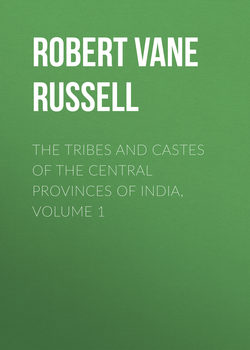Читать книгу The Tribes and Castes of the Central Provinces of India, Volume 1 - Robert Vane Russell - Страница 25
Part I.
Introductory Essay on Caste
Introductory Essay on Caste
22. The clan and the village
ОглавлениеIt has been seen also that Visha in the plural signified clans. The clan was the small body which lived together, and in the patriarchal stage was connected by a tie of kinship held to be derived from a common ancestor. Thus it is likely that the clans settled down in villages, the cultivators of one village being of the same exogamous clan. The existing system of exogamy affords evidence in favour of this view, as will be seen. All the families of the clan had cultivating rights in the land, and were members of the village community; and there were no other members, unless possibly a Kshatriya headman or leader. The Sūdras were their labourers and serfs, with no right to hold land, and a third intermediate class of village menials gradually grew up.
The law of Mirāsi tenures in Madras is perhaps a survival of the social system of the early village community. Under it only a few of the higher castes were allowed to hold land, and the monopoly was preserved by the rule that the right of taking up waste lands belonged primarily to the cultivators of the adjacent holdings; no one else could acquire land unless he first bought them out. The pariahs or impure castes were not allowed to hold land at all. This rule was pointed out by Mr. Slocock, and it is also noticed by Sir Henry Maine: “There are in Central and Southern India certain villages to which a class of persons is hereditarily attached, in such a manner that they form no part of the natural and organic aggregate to which the bulk of the villagers belong. These persons are looked upon as essentially impure; they never enter the village, or only enter reserved portions of it; and their touch is avoided as contaminating. Yet they bear extremely plain marks of their origin. Though they are not included in the village, they are an appendage solidly connected with it; they have definite village duties, one of which is the settlement of boundaries, on which their authority is allowed to be conclusive. They evidently represent a population of alien blood whose lands have been occupied by the colonists or invaders forming the community.”52 Elsewhere, Sir Henry Maine points out that in many cases the outsiders were probably admitted to the possession of land, but on an inferior tenure to the primary holders or freemen who formed the cultivating body of the village; and suggests that this may have been the ground for the original distinction between occupancy and non-occupancy tenants. The following extract from a description of the Marātha villages by Grant Duff53 may be subjoined to this passage: “The inhabitants are principally cultivators, and are now either Mirāsidars or Ooprees. These names serve to distinguish the tenure by which they hold their lands. The Oopree is a mere tenant-at-will, but the Mirāsidar is a hereditary occupant whom the Government cannot displace so long as he pays the assessment on his field. With various privileges and distinctions in his village of minor consequence, the Mirāsidar has the important power of selling or transferring his right of occupancy at pleasure. It is a current opinion in the Marātha country that all the lands were originally of this description.”
As regards the internal relations of clans and village groups, Sir H. Maine states: “The men who composed the primitive communities believed themselves to be kinsmen in the most literal sense of the word; and, surprising as it may seem, there are a multitude of indications that in one stage of thought they must have regarded themselves as equals. When these primitive bodies first make their appearance as landowners, as claiming an exclusive enjoyment in a definite area of land, not only do their shares of the soil appear to have been originally equal, but a number of contrivances survive for preserving the equality, of which the most frequent is the periodical redistribution of the tribal domain.”54 Similarly Professor Hearn states: “The settlement of Europe was made by clans. Each clan occupied a certain territory—much, I suppose, as an Australian squatter takes up new country. The land thus occupied was distributed by metes and bounds to each branch of the clan; the remainder, if any, continuing the property of the clan.”55 And again: “In those cases where the land had been acquired by conquest there were generally some remains of the conquered population who retained more or less interest in the lands that had once been their own. But as between the conquerors themselves it was the clansmen, and the clansmen only, who were entitled to derive any advantage from the land that the clan had acquired. The outsiders, the men who lived with the clan but were not of the clan, were no part of the folk, and had no share in the folkland. No services rendered, no participation in the common danger, no endurance of the burden and heat of the day, could create in an outsider any colour of right. Nothing short of admission to the clan, and of initiation in its worship, could enable him to demand as of right the grass of a single cow or the wood for a single fire.”56
52
Village Communities, p. 127.
53
History of the Marāthas, vol. i. p. 25.
54
Village Communities, pp. 226, 227.
55
The Aryan Household, ed. 1891, p. 190.
56
Ibidem, p. 228. Professor Hearn followed Sir Henry Maine in thinking that the clan was an expansion of the patriarchal joint family; but the reasons against this view are given subsequently.
